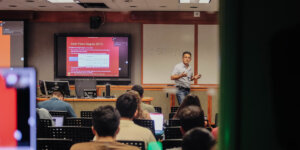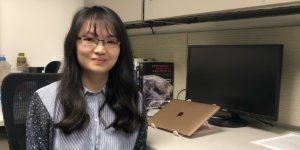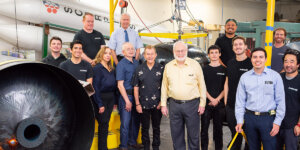
Photo credit: Airbus
USC Viterbi Professor Steve Nutt travels by airplane five or six times per year.
When he looks out the window while cruising some 35,000 above the ground and he reflects on the vessel he’s riding in, his mind takes him to far-more nuanced places than the average flier.
While a typical passenger might marvel at the endless sky and ponder the miracle of flight — how is this plane staying up in the air? — Nutt’s mind takes him into the airplane’s unseen guts, namely, the composite materials that are in everything from the fan blades of the jet engine to the fuselage and the wings.
Nutt, the M.C. Gill Chair in the Mork Family Department of Chemical Engineering and Material Sciences and founding director of the M.C. Gill Composites Center, thinks about new ways to make composite materials so the airplane manufacturing process can become more streamlined.
Over the last decade, he and two other USC Viterbi colleagues have been involved in separate outside-the-box aerospace research projects with Korean Air, European aircraft manufacturer Airbus, and two Korean Universities, Inha University and the Korean Aerospace University. USC Viterbi scholars say this global collaboration someday could lead to landmark developments in the commercial aviation industry.
Although formed in 2004 with an initial research budget of $5 million provided by Airbus, the partnership — the Aerospace Institute for Engineering Research (AIER), located at USC — really took flight in 2008, with the launching of Nutt’s research into composites and two other research efforts by USC Viterbi professors Ulrich Neumann and Gerard Medioni.
USC Viterbi Dean Yannis C. Yortsos has hailed the AIER partnership as “a global collaboration that enriches research in aerospace engineering.”
The professors agree.
“The (collaboration) has been very valuable,” said Neumann, a USC Viterbi professor of computer science whose research in object recognition and tracking is used to augment live video imagery with annotations that guide workers through airplane maintenance procedures.
“It’s been an interesting meld of the academic side and the commercial side, where we work on technology to be applied to industry,” added Neumann, the former director of USC’s Integrated Media Systems Center. “I think it’s a good thing for both parties, and I think that we should do more of it.”
Medioni’s project involved the use of infrared imagery to detect obstacles on runways to help ensure safer landings.
A GLOBAL PARTNERSHIP
In May 2013, a new partnership that represents an extension of the previous AIER collaboration formed. The newly named Airbus Institute for Engineering Research includes USC Viterbi, Airbus, Korean Air and two of its research affiliates, Inha University in Incheon and the Korea Aerospace University in Goyang.
“We’ve become one of the foremost groups in the world doing this type of work,” Nutt said of his team of about 30 at the M.C. Gill Composites Center, whose AIER-related research involves the creation of an “out of autoclave” composite fabrication technique.
Autoclaves are huge, pressurized ovens used for curing airplane materials made from composites.
These giant pressure-cookers, cranked up to 250 degrees Fahrenheit, eliminate moisture, bubbles and other defects that occur when composite materials are arranged layer by layer and in curved shapes to make an airplane wing.
Think of layers of fiber-reinforced tape that have to be smoothed over perfectly so there are no air bubbles or moisture trapped underneath. That’s what autoclaves achieve for airplane parts.
Autoclaves, however, are costly to build and operate and represent a production bottleneck, since airplane parts have to be processed in them for several hours — sometimes all day. Nutt and his fellow researchers have developed a different way to assemble composite materials so they can be cured in conventional ovens and still be soundly constructed. Unlike traditional composite materials such as those used to make surfboards and hulls of boats, airplane parts require tighter level of compactness.
The trick was coming up with a new way to put together a composite material called pre-preg, which are fibers pre-impregnated with epoxy resin. The aerospace industry now almost exclusively uses pre-preg since it achieves the highest levels of performance.
A KEY INVENTION
Nutt and his team developed an alternative out-of-autoclave pre-preg format they call “USCpreg” in which they replaced continuous resin patterns with discontinuous resin patterns. This modification shortened the pathways needed for air and moisture to escape the composite material during the curing process, like air bubbles being pressed out of packing tape.
“That’s been our key invention,” Nutt said. “Right now, we’re trying to advance the technology and demonstrate a pathway to commercialization.”
Nutt said his team’s out-of-autoclave pre-peg research still is at the “proof-of-concept” stage, which means research has shown the idea to be feasible.
“The results have been just astounding,” Nutt said. “The research project sponsored through the AIER has had a big impact on USC, and potentially will have a big impact on the aviation industry,” Nutt said. “I think that if we don’t make these new out-of-autoclave pre-pegs ourselves, then someone else will. But we’re way ahead of the curve.”
LANDING, MAINTENANCE AIDS
Medioni, a USC Viterbi professor of computer science, oversaw in 2008-2011 a project with Korean Air that involved a video-assisted tracking system to recognize runway hazards during approach and landing.
“The goal of the research was not directly to assist pilots, but to allow autonomous landings on any runway for large UAVs (unmanned aerial vehicles),” Medioni said.
His team’s work involved using infrared imagery to detect runways in all weather, day or night, and to detect obstacles on them.
Medioni’s team created the software and computer platform to process the video imagery in real time.
“We implemented the system and flew it in real planes on real runways in Korea,” Medioni said. “The system correctly identified obstacles and aborted landings in real tests.”
Neumann, meanwhile, oversaw a project from 2008-2011 that was one of the first of its kind involving the use of Intelligent Augmented Reality (IAR) technology, which today is more commonly used for immersive entertainment.
Neumann and his team created software that could recognize and track aircraft components in a live video stream. The software allowed intelligent annotations created by the Inha University partners to be overlaid on the imagery to guide the activities of technicians and verify that procedures were done correctly.
“It was a very complex project,” Neumann said. “The computer had to figure out what it was looking at and the right conditions to trigger and place the correct annotations. It’s a difficult recognition problem, and it was uncommon to use recognition for AR systems back then.”
Korean Air has an airplane maintenance facility in Pusan where technicians work not only on Korean Air planes but also on ones from all over the world. The idea was to use IAR technology to certify maintenance operations were being done according to specification.
Such a system, when implemented, would reduce the training time for technicians as well as reduce the chance of human error, Neumann said.
The proof of concept his team developed focused on the disassembly and repair of landing gear.
“I had never been exposed to such detail about airplane landing gear before,” Neumann said.
The system presented technicians with various graphics and text messages superimposed on each component on a live video display system. Technicians would point the IAR video camera at the work scene, and the software would overlay annotations showing warnings, cautions and maintenance procedure instructions.
Neumann and his team demonstrated the system in a hangar in South Korea.
“At that point in time,” he said, “I don’t think maintenance technicians had ever seen anything like it.”
Like Nutt’s research project, Neumann’s achieved the proof-of-concept stage.
TIME-CONSUMING PROCESS
Although Korean Air would have loved to have been presented a turnkey IAR application that it could have quickly employed, such a system requires years of testing and review in an industry that is heavily regulated for a good reason: to ensure the safety of air travel.
“You don’t just mess around with the maintenance procedures of aircraft or stick a new system in an aircraft and say, ‘OK, let’s go,’” said Neumann.
He felt the research project was valuable to both USC Viterbi researchers and Korean Air employees.
“When working on such projects, everyone involved pushes a little out of their comfort zone,” Neumann said. “Here we were, a bunch of academics showing up with computers and cameras to work with airline maintenance crews in South Korea.”
Neumann said that even though real-world applications of his and the other two AIER research projects still are years away, their studies yielded valuable dividends.
“Raising awareness of these research and application concepts is a huge benefit,” Neumann said. “I think that’s one of the big values for everybody: learning about real-world challenges and problems, and then trying new technologies that may be able to solve them.”
PUSH TO COMMERCIALIZE
Nutt and his team are actively working on pushing the USCpreg invention toward commercialization. The team currently has a Technology Advancement Grant (TAG) from USC and is building prototype devices to make USCpreg.
Nutt’s team also has applied for funding to advance the technology even further through NSF’s Partnerships for Innovation program. For that proposal, the team has identified key collaborators, including Airbus and some pre-preg manufacturers, and has filed for domestic and international patents on the technology.
“We expect that the invention will soon be commercialized, although the breadth of the impact is yet to be determined,” Nutt said.
Published on April 18th, 2018
Last updated on April 18th, 2018











